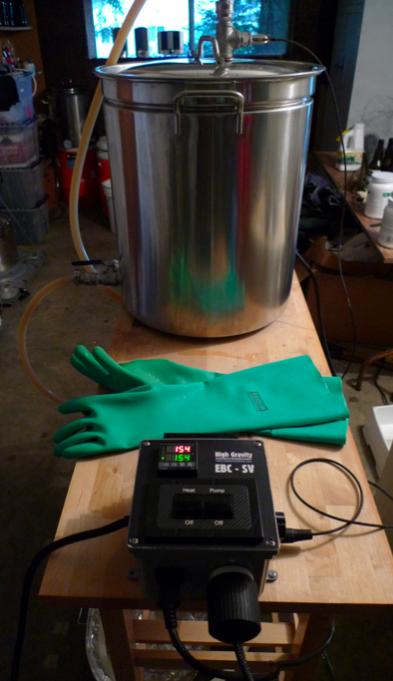On the batch I used the voile I was able to get a recirc going but I had to tinker with the bag and had it pulled pretty tight before it was stable. That may mean its just on the edge and if you throttle back the pump with a valve it may work OK. It's just not something I'm planning to do though when it works just fine with the coarser bag.
When I first started researching BIAB appr 2 years ago, I began on the biabrewer.com forum. There was much talk about the bag material with particular emphasis on the fine-meshed voile over the coarser paint strainer or laundry bags. I forget the exact reasons. I think the finer bag allowed for a bit finer crush to be used thereby increasing efficiency. Also, the finer bag did not leave behind as much junk in the kettle.
When I discovered HBT, I stumbled upon, and was most encouraged by, builds by thughes, johnodon (no longer brewing, but his thread is still up), jsguitar, and voltin. I think they all used recirculation, the swiss voile bag, as well as the basket. Thughes abandoned recirculation as well as the basket, IIRC. Somewhere on HBT are is a thread that asks who's recirculating during mash (with BIAB) and another that asks who's still using the basket. It seems that many are abandoning one or the other or both.
One common problem with recirculation was that of starving the pump. Spacemanspiff, it sounds like this is what is happening when you use the voile bag. On the thread(s) where this is discussed, it was mentioned that
there should be a valve at the pump outlet to control the flow and that the flow should be quite slow. IOW, you open your kettle valve completely but shut down your post-pump valve considerably. On Kal's website in his section "Brew Day Step by Step" he shows the pump valves barely open during the sparge.
Anyway, bottom line #1: if folks are having trouble with recirculation, it would be interesting to hear the results if you insert a 2nd valve at the pump outlet.
Bottome line #2: Something that negates much of what I repeated regarding the bag just occured to me. Many brewers perform a brief manual recirc after dough-in using a pitcher until the wort loses its cloudiness. Apparently, the grain bed acts as its own filter. This could provide justification for using the coarser bags for those who feel that recirculation is important for maintaining consistent mash temps.
Sorry about being so long-winded. While some people might abandon a project because they jump into it without thinking things thru, I, OTOH, often spend way too much time overthinking the project and performing many "dry runs" in my mind that I never embark on the project. I need to find the happy medium.
Thanks,
Keith





